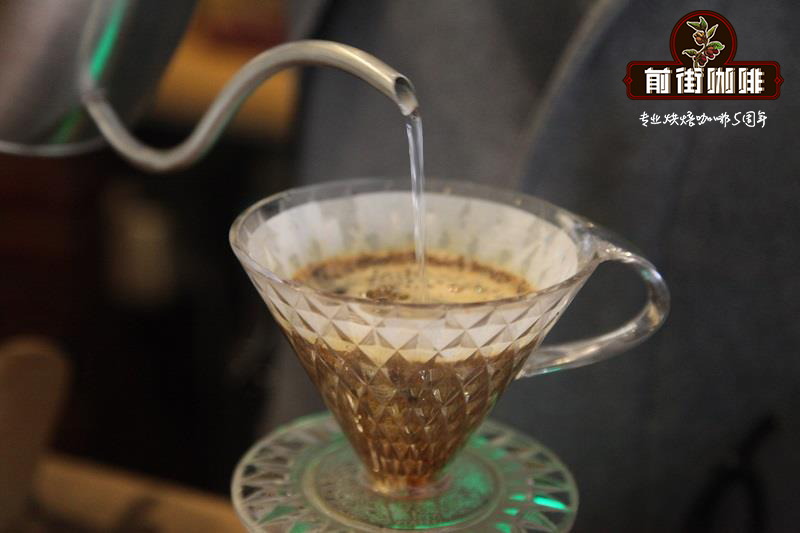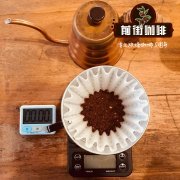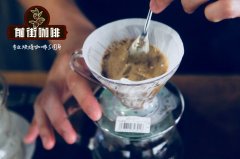The method of selecting fresh hand-brewed coffee beans. The roasting date of hand-made coffee beans is very important!

Professional coffee knowledge exchange more coffee bean information please follow the coffee workshop (Wechat official account cafe_style)
Fresh, is the king of delicious coffee.
More and more people are getting used to buying freshly roasted hand-made coffee beans directly from bakeries, so there are many tips to teach people how fresh hand-made coffee beans are.
How to judge the freshness of hand-made coffee powder?
Among them, the most common one is:
Whether there are enough bubbles when brewing.
The abundance of bubbles is the expression of freshness.
Freshly roasted hand-brewed coffee beans, because the beans contain a lot of gas, strong respiration, in the hand water, the beans released gas, we see is wonderful plump bubbles, there is a very vivid adjective, "blooming". Yes, when fresh coffee beans are extracted, clumps of rich bubbles bloom like flowers of this season.
It is accompanied by the rich aroma of fresh coffee beans.
An in-depth study of whether bubbles are abundant or not
During extraction, the richness of bubbles is positively related to freshness. The fresher the bubbles are, the more bubbles are. However, there is a premise for the same coffee bean. To be exact, it is the same raw beans, the same baking, the same operation.
The fullness of bubbles will be different between different coffee beans, or between different roasting degrees of the same coffee bean, or between different operating coefficients of the same coffee bean.
To sum up: the fresher the same coffee bean, the richer the bubbles; for the same coffee bean, deep roasting is more abundant than shallow roasting bubbles.
And between different coffee beans, apart from the differences in baking degree and other factors, only from their own structure, will also reflect the difference in hydrophilicity, the most intuitive reflected in the speed of water absorption and the degree of blistering.
Suggestions for adjusting extraction
For the same coffee bean, if the existing operation mode of extraction is not ideal, you can consider: increasing the number of coffee powder, increasing the thickness of the powder layer, increasing the combination time of coffee powder and water; increasing the extraction water temperature, further stimulating the activity of coffee beans; reducing the degree of grinding, grinding a little finer, and increasing the contact area between coffee powder and water molecules.
Of course, the above advice is for fresh coffee beans.
The regulation of each extraction factor will have a certain impact on the final taste of coffee. For the taste of the last cup, we still need to rely on the maker's grasp.
Also, when we judge fresh coffee beans, we should also consider whether the raw beans are fresh or not.
60% of a good cup of coffee depends on the quality of raw beans. As a coffee practitioner, you should let go of the situation and learn as much as possible about coffee seeds to coffee cups. Advanced Level 6 | from a bean to a cup of coffee, establish a coffee knowledge system. This is helpful to the link you are engaged in. After all, bakers bake according to beans, while baristas brew through beans and baking ideas.
The new and old degrees of raw beans are different.
With the same kinds of beans, manors, elevations and planting methods, there is a great difference between new raw beans and old beans in dry and wet fragrance. Because coffee is also a kind of crop, freshness is very important for coffee.
Generally speaking, fresh coffee beans harvested that year are called "New Corp", those harvested the year before last are called "old beans" (Past Corp), and those placed for more than a year are called "old beans" (Old Corp). This distinction is mainly due to the water content of raw beans, because the new beans have a high water content (usually between 11% murmur13%) and are mostly dark green in appearance, while the old beans (10% murmur11%) and the old beans (9% copyright 10%) have a lighter green appearance, lighter weight and mildness, and will not be as shiny and tactile as the new bean surface. Of course, different processing and refining methods and producing areas, varieties of raw beans will be different.
Xindou: the surface is so shiny and tactile
Changes in freshness of raw beans:
New season beans > overdue season beans > old beans > old beans
New season beans: raw beans harvested within one year
Over-yielding seasonal beans: more than one year.
Lao Dou: more than two years
Aged beans: ripe raw beans.
For example, after a year at room temperature, the water content of raw beans will drop to less than 10%. The color of raw beans just processed is blue-green / green, but as time goes on, the color of raw beans will gradually become light green, white or yellow. And with the extension of raw frying, the aroma of raw beans will change from grass and spice to hay or rice, and for a longer time, it will be completely tasteless.
The mature "coffee cherry" is refined into raw beans by washing or drying. The water content is usually between 9% and 13%, and it is not easy to bake if the water content is too high or too low.
Generally speaking, we get the newly harvested raw beans with a water content of about 11.5% murmur12.5%, half-washed manning may be up to 13%, half-washed Brazil is 11% Muth12%, and sun-dried mochas have a wide range of about 9%, between 12% and 12%.
Coffee can be drunk all the year round, but high-quality coffee also has season problems. in fact, coffee and fruit are the same, there are seasonal and out-of-season problems as well.
However, coffee is grown in at least 60 countries on three continents, and the growing seasons in the northern and southern hemispheres are different, complicating the problem. Coffee fans can master the seasons of various producing areas by using more snacks, and it is easier to buy rich fresh beans.
When the rainy season in the coffee producing area begins, which is related to the time of receipt, the rainy season promotes the coffee trees to blossom and bear fruit. After about 6 murals for 9 months, the coffee fruit turns red, and the fruit can be peeled, washed and fermented, semi-washed or sun-treated (with shell bean moisture content up to 12%). It can be stored for ripening for 3 months, and finally the seed shell can be ground off for export.
In other words, after the harvest, it will take at least 3 months to complete the tedious post-processing before the coffee beans can be exported.
Generally speaking
The Central American producing region of the Northern Hemisphere or Aceh in Indonesia is the busiest harvest and post-harvest period from February to March each year, so the beans of the current season can be shipped to the consuming countries in about May-October.
Brazil in the southern hemisphere has the busiest delivery and post-production period from May to July, while beans arrive from September to April of the following year.
Fresh beans are harvested in Africa from May to October, so the beans can be delivered to consumer countries in January-March of the following year.
Colombia has a fresh fruit harvest of coffee all the year round
In addition, if the producing country crosses the equator, the producing areas are distributed in the northern and southern hemispheres, such as Kenya, there will be two harvest periods, that is, fresh beans are exported in all seasons, and Kona in Hawaii is from August to January of the following year.
Vietnam, Thailand and Yunnan generally harvest fresh fruits in November-January of the following year.
Papua New Guinea from April to September every year
The annual harvest time of Jamaican Blue Mountain Coffee is from June to November.
With different preservation methods, the flavor and aroma are maintained for different times.
No matter how good the quality of raw beans is, they will vary according to different preservation methods and facilities. The ideal thing is to maintain an indoor temperature of 15 Murray 18 degrees Celsius and indoor humidity of 50% Murray 60%. The wrong way of preservation will affect the flavor and aroma of beans, and even deteriorate. It often causes raw beans to fade and whiten and become wet and soft.
White or yellow raw beans: because the temperature of the storage place is too high, or too dry, the moisture of the raw beans will be absorbed by the air.
Raw beans with moist surface: the humidity in the storage place is too high, during the rainy season. If the condition is serious, mold will appear on the surface of the beans.
Coffee roasting | Old and new beans
The water content of raw beans will affect the baking time and the degree of difficulty to control. Usually, the baking time of new beans is longer and harder to control than old beans.
Of course, coffee raw beans are usually as fresh as possible. Fresh coffee raw beans are full of vitality. Semi-fresh raw beans, vitality with a little bit of stability, eight months after the raw beans, the loss of vitality.
Coffee is a futures and will indicate the year of production. Generally speaking, it will be cross-year, at the beginning of the year is to drink last year and the year before last batch, slowly into last year and this year batch. For example, it is common to drink 2016-17 batches at the beginning of 2018, and 2017-18 batches will not be available until a few months later. There are also some coffee raw bean manufacturers who do not use the new year score as the batch standard, for example, 90 + is based on a single year as the batch standard.
As can be seen from the above, if the coffee bean merchants hoarded the used goods of the past, they may have been stored for a long time from 3.4 years ago, then even if such raw coffee beans are properly stored, their flavor will certainly be different from those of fresh batches of raw beans. As for the difference, it depends on the level of storage and the speed of oxidation of the beans themselves. Aged beans are another topic-it's well-managed coffee ripening, but not all coffee beans are suitable for aging.
Raw beans for more than one year are old and boring, but the above comments are only applicable to general coffee beans in the general preservation state, but not to specially treated beans and special preservation environment, such as low-cause treatment, aging, wind stain treatment and so on. that's another area of appreciation.
Boutique coffee shops often prefer to have fresh batches. After all, the time is terrible, and it is unknown how much the flavor of the coffee will be taken away. Of course, the roaster does not want the raw beans they buy to be in a situation where the flavor is only 50%. This is the act of throwing money into the water.
It can be seen from the above that raw beans should be fresh, and there can be no mistakes in production, transportation and storage, otherwise coffee beans will have doubts that they are not fresh.
Under the premise of proper storage, there is no certain formula for time and taste period, but related to bean species and treatment methods. Washed beans with bright flavor, such as Kenya in Kenya, Costa Rica in Costa Rica, Kona in Hawaii, etc., should not be preserved for a long time. Fresh beans have the most fragrant original flavor of coffee fruit.
Finally, the coffee bean surface is judged to be fresh.
What is the relationship between the "oil" of coffee beans and the freshness? Should we buy coffee beans that are "oily" or "unoiled" in appearance?
Coffee oil that is not oil:
These "oils" distributed evenly on the surface of coffee beans are actually not "oils", but water-soluble organic substances that look like oils. "Coffee oil" itself contains many aroma ingredients of coffee, which can be dissolved in water, so the surface of your brewed coffee will not be covered with greasy oil.
There are two reasons for "out of oil beans".
A) stale shallow baked beans
The "light baked beans", which are light in heat and light brown in appearance, are dry and will not produce oil after baking. About five days after it comes out of the oven (it may be shortened to one or two days at the height of summer), the phenomenon of "spot oil" begins to appear (dotted oil droplets appear on one side of the coffee bean) Please note: a little "spot oil" does not mean it is not fresh. sometimes the flavor of light-roasted coffee beans is at its peak. Continue to put, more than two weeks after the oven, the surface of shallow baked beans gradually covered with a uniform, thin and bright oil, the smell is not sweet, but with fuel consumption, at this time, the flavor of "shallow baked beans" has gone downhill and should be avoided.
B) fresh deep baked beans
The deep-baked beans with dark brown appearance show a slight glossy appearance after baking, and a large amount of oil begins to appear on the surface from the first day to the second day. The bright-looking "deep-baked beans" not only do not mean that they are not fresh, on the contrary, the deep-baked beans will gradually dry out three weeks after they come out of the oven, and finally become dry-flavored beans. Therefore, if you see coffee beans that are dry but dark brown in appearance, please pay special attention to whether they are marked with the date of baking, which is most likely to be spoiled beans.
Even if it is not fresh, the appearance of the "shallow baked beans" will gradually dry out after a long time (such as three months), and finally return to the dry and unoily appearance. Thus it can be seen that the appearance of oil is only a reference to judge the freshness of coffee beans, not absolutely. Therefore, most roasters have clearly marked baking dates, and we choose professional coffee roasters who have brand reputation and emphasize fresh roasting.
Good coffee bags are usually designed with a "one-way exhaust valve" (a button-shaped hole in the top of the coffee bag) for coffee beans to release naturally occurring carbon dioxide. Point the one-way exhaust valve at the nose, gently squeeze the coffee bag and smell the gas. If it is a charming and fragrant coffee aroma, the freshness will not be a problem. On the contrary, if it does not smell strong enough, or even smells of smelly oil, it means that this bag of coffee has already gone bad and should be avoided.
END
Important Notice :
前街咖啡 FrontStreet Coffee has moved to new addredd:
FrontStreet Coffee Address: 315,Donghua East Road,GuangZhou
Tel:020 38364473
- Prev

Hand-in-hand teaches you to choose hand-brewed coffee beans _ what do you have in hand-what coffee beans are suitable for hand-brewing?
Professional coffee knowledge exchange more coffee bean information Please pay attention to coffee workshop (Wechat official account cafe_style) Coffee many people like to drink coffee, with the continuous improvement of the quality of life, we used to choose finished coffee or instant coffee, but now we may enjoy making a cup by ourselves. And if you want to enjoy the good mood of life, you are changing hands.
- Next

Why does your hand make coffee so bad? The thickness and water temperature of hand coffee powder are the most important!
Professional coffee knowledge exchange more coffee bean information Please follow the coffee workshop (Wechat official account cafe_style) many people used to buy coffee beans directly from a coffee shop, only to find that they rushed out of the coffee shop taste when they were brewing. Obviously they are the same coffee beans, why is the hand-brewed coffee made by myself not good? Extraction of hand-made coffee is not just about extraction.
Related
- Beginners will see the "Coffee pull flower" guide!
- What is the difference between ice blog purified milk and ordinary milk coffee?
- Why is the Philippines the largest producer of crops in Liberia?
- For coffee extraction, should the fine powder be retained?
- How does extracted espresso fill pressed powder? How much strength does it take to press the powder?
- How to make jasmine cold extract coffee? Is the jasmine + latte good?
- Will this little toy really make the coffee taste better? How does Lily Drip affect coffee extraction?
- Will the action of slapping the filter cup also affect coffee extraction?
- What's the difference between powder-to-water ratio and powder-to-liquid ratio?
- What is the Ethiopian local species? What does it have to do with Heirloom native species?

